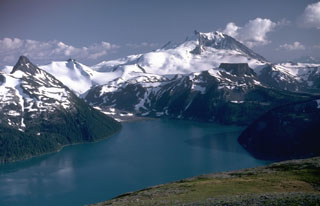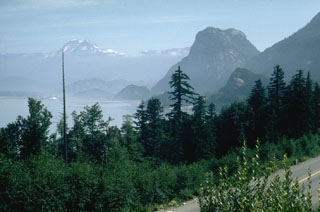

The Global Volcanism Program has no activity reports available for Garibaldi.
The Global Volcanism Program has no Weekly Reports available for Garibaldi.
The Global Volcanism Program has no Bulletin Reports available for Garibaldi.
|
|
||||||||||||||||||||||||||
There is data available for 1 confirmed eruptive period.
8060 BCE ± 500 years Confirmed Eruption (Explosive / Effusive) VEI: 3 (?)
| Episode 1 | Eruption (Explosive / Effusive) | SE flank (Opal Cone) | ||||||||||||||||||||||||||||
|---|---|---|---|---|---|---|---|---|---|---|---|---|---|---|---|---|---|---|---|---|---|---|---|---|---|---|---|---|---|
| 8060 BCE ± 500 years - Unknown | Evidence from Isotopic: 14C (uncalibrated) | ||||||||||||||||||||||||||||
|
List of 4 Events for Episode 1 at SE flank (Opal Cone)
|
|||||||||||||||||||||||||||||
This compilation of synonyms and subsidiary features may not be comprehensive. Features are organized into four major categories: Cones, Craters, Domes, and Thermal Features. Synonyms of features appear indented below the primary name. In some cases additional feature type, elevation, or location details are provided.
Cones |
||||
| Feature Name | Feature Type | Elevation | Latitude | Longitude |
| Eanastick Meadow
Enostuck Meadow Eonostuck Meadow |
Vent | 1160 m | 49° 48' 0.00" N | 123° 55' 0.00" W |
| Opal Cone | Cone | 1740 m | 49° 49' 0.00" N | 122° 58' 0.00" W |
| Round Mountain | Vent | |||
Domes |
||||
| Feature Name | Feature Type | Elevation | Latitude | Longitude |
| Atwell Peak | Dome | 2550 m | 49° 51' 0.00" N | 123° 0' 0.00" W |
| Columnar Peak | Dome | 1830 m | 49° 48' 0.00" N | 123° 0' 0.00" W |
| Dalton Dome | Dome | 2633 m | 49° 51' 0.00" N | 123° 0' 0.00" W |
| Glacier Pikes | Dome | 2137 m | 49° 52' 46.00" N | 122° 58' 43.00" W |
 Mount Garibaldi, rising above Garibaldi Lake to the north, is a largely Pleistocene stratovolcano with a summit lava dome complex. The volcano was partially constructed over the Cordilleran ice sheet and contains many ice-contact features. Its final eruptions during the early Holocene included lava flows that mantled the western landside scarp and a massive lava flow from Opal Cone, a SE flank vent, that traveled 20 km to the south and west.
Mount Garibaldi, rising above Garibaldi Lake to the north, is a largely Pleistocene stratovolcano with a summit lava dome complex. The volcano was partially constructed over the Cordilleran ice sheet and contains many ice-contact features. Its final eruptions during the early Holocene included lava flows that mantled the western landside scarp and a massive lava flow from Opal Cone, a SE flank vent, that traveled 20 km to the south and west. The Pleistocene Mount Garibaldi was partially constructed over the Cordilleran ice sheet. Its western face, seen from near Alice Lake, exposes the interior structure of the volcano and resulted from repeated landslides from the steep slope remaining from when the continental ice sheet retreated. The summit peak to the right is Atwell Peak and the rounded peak to the left is Dalton Dome, the source of some of Garibaldi's most recent eruptions.
The Pleistocene Mount Garibaldi was partially constructed over the Cordilleran ice sheet. Its western face, seen from near Alice Lake, exposes the interior structure of the volcano and resulted from repeated landslides from the steep slope remaining from when the continental ice sheet retreated. The summit peak to the right is Atwell Peak and the rounded peak to the left is Dalton Dome, the source of some of Garibaldi's most recent eruptions. Mount Garibaldi rises above Howe Sound, 80 km N of Vancouver. The steep-sided peak on the right is the Squamish Chief, a glacially eroded peak of the Coast Range batholith. Garibaldi was constructed during the Pleistocene, partially overriding the Cordilleran ice sheet. Retreat of the ice sheet left the western side of the volcano unsupported, causing many landslides into the Cheakamus River valley.
Mount Garibaldi rises above Howe Sound, 80 km N of Vancouver. The steep-sided peak on the right is the Squamish Chief, a glacially eroded peak of the Coast Range batholith. Garibaldi was constructed during the Pleistocene, partially overriding the Cordilleran ice sheet. Retreat of the ice sheet left the western side of the volcano unsupported, causing many landslides into the Cheakamus River valley. The Table, the flat-topped ridge in the foreground in front of Mount Garibaldi, is the southernmost vent of the Garibaldi Lake volcanic field. This is a tuya that formed when lava flows filled a pit melted through the continental ice sheet. A series of stacked horizontal lava flows filling the pit formed The Table.
The Table, the flat-topped ridge in the foreground in front of Mount Garibaldi, is the southernmost vent of the Garibaldi Lake volcanic field. This is a tuya that formed when lava flows filled a pit melted through the continental ice sheet. A series of stacked horizontal lava flows filling the pit formed The Table.  Mount Garibaldi is to the left in the background. In the foreground are glacially eroded granitic rocks of the Coast Range Batholith that extend south to the Mount Seymour area in the foreground, immediately north of the city of Vancouver.
Mount Garibaldi is to the left in the background. In the foreground are glacially eroded granitic rocks of the Coast Range Batholith that extend south to the Mount Seymour area in the foreground, immediately north of the city of Vancouver. The following 2 samples associated with this volcano can be found in the Smithsonian's NMNH Department of Mineral Sciences collections, and may be availble for research (contact the Rock and Ore Collections Manager). Catalog number links will open a window with more information.
| Catalog Number | Sample Description | Lava Source | Collection Date |
|---|---|---|---|
| NMNH 116136-1 | Alkalic Basalt | -- | -- |
| NMNH 116136-2 | Hypersthene Andesite | -- | -- |
| Copernicus Browser | The Copernicus Browser replaced the Sentinel Hub Playground browser in 2023, to provide access to Earth observation archives from the Copernicus Data Space Ecosystem, the main distribution platform for data from the EU Copernicus missions. |
| MIROVA | Middle InfraRed Observation of Volcanic Activity (MIROVA) is a near real time volcanic hot-spot detection system based on the analysis of MODIS (Moderate Resolution Imaging Spectroradiometer) data. In particular, MIROVA uses the Middle InfraRed Radiation (MIR), measured over target volcanoes, in order to detect, locate and measure the heat radiation sourced from volcanic activity. |
| MODVOLC Thermal Alerts | Using infrared satellite Moderate Resolution Imaging Spectroradiometer (MODIS) data, scientists at the Hawai'i Institute of Geophysics and Planetology, University of Hawai'i, developed an automated system called MODVOLC to map thermal hot-spots in near real time. For each MODIS image, the algorithm automatically scans each 1 km pixel within it to check for high-temperature hot-spots. When one is found the date, time, location, and intensity are recorded. MODIS looks at every square km of the Earth every 48 hours, once during the day and once during the night, and the presence of two MODIS sensors in space allows at least four hot-spot observations every two days. Each day updated global maps are compiled to display the locations of all hot spots detected in the previous 24 hours. There is a drop-down list with volcano names which allow users to 'zoom-in' and examine the distribution of hot-spots at a variety of spatial scales. |
|
WOVOdat
Single Volcano View Temporal Evolution of Unrest Side by Side Volcanoes |
WOVOdat is a database of volcanic unrest; instrumentally and visually recorded changes in seismicity, ground deformation, gas emission, and other parameters from their normal baselines. It is sponsored by the World Organization of Volcano Observatories (WOVO) and presently hosted at the Earth Observatory of Singapore.
GVMID Data on Volcano Monitoring Infrastructure The Global Volcano Monitoring Infrastructure Database GVMID, is aimed at documenting and improving capabilities of volcano monitoring from the ground and space. GVMID should provide a snapshot and baseline view of the techniques and instrumentation that are in place at various volcanoes, which can be use by volcano observatories as reference to setup new monitoring system or improving networks at a specific volcano. These data will allow identification of what monitoring gaps exist, which can be then targeted by remote sensing infrastructure and future instrument deployments. |
| Volcanic Hazard Maps | The IAVCEI Commission on Volcanic Hazards and Risk has a Volcanic Hazard Maps database designed to serve as a resource for hazard mappers (or other interested parties) to explore how common issues in hazard map development have been addressed at different volcanoes, in different countries, for different hazards, and for different intended audiences. In addition to the comprehensive, searchable Volcanic Hazard Maps Database, this website contains information about diversity of volcanic hazard maps, illustrated using examples from the database. This site is for educational purposes related to volcanic hazard maps. Hazard maps found on this website should not be used for emergency purposes. For the most recent, official hazard map for a particular volcano, please seek out the proper institutional authorities on the matter. |
| IRIS seismic stations/networks | Incorporated Research Institutions for Seismology (IRIS) Data Services map showing the location of seismic stations from all available networks (permanent or temporary) within a radius of 0.18° (about 20 km at mid-latitudes) from the given location of Garibaldi. Users can customize a variety of filters and options in the left panel. Note that if there are no stations are known the map will default to show the entire world with a "No data matched request" error notice. |
| UNAVCO GPS/GNSS stations | Geodetic Data Services map from UNAVCO showing the location of GPS/GNSS stations from all available networks (permanent or temporary) within a radius of 20 km from the given location of Garibaldi. Users can customize the data search based on station or network names, location, and time window. Requires Adobe Flash Player. |
| DECADE Data | The DECADE portal, still in the developmental stage, serves as an example of the proposed interoperability between The Smithsonian Institution's Global Volcanism Program, the Mapping Gas Emissions (MaGa) Database, and the EarthChem Geochemical Portal. The Deep Earth Carbon Degassing (DECADE) initiative seeks to use new and established technologies to determine accurate global fluxes of volcanic CO2 to the atmosphere, but installing CO2 monitoring networks on 20 of the world's 150 most actively degassing volcanoes. The group uses related laboratory-based studies (direct gas sampling and analysis, melt inclusions) to provide new data for direct degassing of deep earth carbon to the atmosphere. |
| Large Eruptions of Garibaldi | Information about large Quaternary eruptions (VEI >= 4) is cataloged in the Large Magnitude Explosive Volcanic Eruptions (LaMEVE) database of the Volcano Global Risk Identification and Analysis Project (VOGRIPA). |
| EarthChem | EarthChem develops and maintains databases, software, and services that support the preservation, discovery, access and analysis of geochemical data, and facilitate their integration with the broad array of other available earth science parameters. EarthChem is operated by a joint team of disciplinary scientists, data scientists, data managers and information technology developers who are part of the NSF-funded data facility Integrated Earth Data Applications (IEDA). IEDA is a collaborative effort of EarthChem and the Marine Geoscience Data System (MGDS). |